
Why Ongoing Discovery of Longtail SaaS Apps Is Critical
Table of Contents ToggleWhat Are Longtail SaaS Applications?The Rise of Longtail...
Back
Back
Search for Keywords...
Blog

Table of Contents
Most companies juggle hundreds of applications—an average of 275 SaaS apps per organization. If managing your software stack feels overwhelming, you’re not alone. IT leaders face increasing pressure to control costs and optimize software usage in a rapidly evolving SaaS environment.
When SaaS portfolios grow unchecked, the impact extends beyond stress, leading to unnecessary spending and inefficiencies. On average, companies now spend $49M annually on SaaS, with $21M wasted on unused licenses. Redundant tools are a major contributor to this waste. Organizations frequently subscribe to multiple applications that serve the same function, paying for duplicate solutions or unused features.
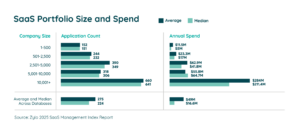
This redundancy isn’t just costly—it can disrupt workflow. Employees in different departments often use separate tools for the same purpose, leading to communication silos and inefficiencies. A project started in one application may be inaccessible to another team, requiring rushed license purchases, added costs, and lost productivity.
Organizations need a structured approach to application rationalization to reduce waste and improve collaboration. A well-defined software rationalization strategy helps businesses consolidate redundant plaatforms, optimize licensing, and streamline SaaS Management for long-term cost savings and efficiency.
Before optimizing your SaaS portfolio, you must determine which applications should stay and which should be consolidated, replaced, or retired. This process—application rationalization—helps organizations take control of their software investments and eliminate unnecessary spending.
However, application rationalization is more than a simple audit. It’s about applying logic and business value to every tool in your SaaS stack. A flashy app might sound impressive, but does anyone actually use it? If not, it’s just another expense without a return.
Every organization has outdated or underutilized tools in its portfolio. Software rationalization helps identify which applications still provide value and which should be removed. It’s not just about eliminating software—it’s about ensuring every application has a clear, strategic purpose.
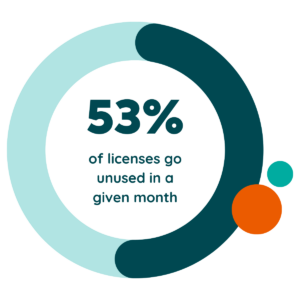 Wasted software spending is a significant financial drain. According to Zylo’s 2025 SaaS Management Index Report, 52.7% of SaaS licenses go unused, costing companies an average of $21M annually in wasted spend. Identifying underutilized tools is critical to preventing unnecessary costs and reallocating resources to higher-value investments.
Wasted software spending is a significant financial drain. According to Zylo’s 2025 SaaS Management Index Report, 52.7% of SaaS licenses go unused, costing companies an average of $21M annually in wasted spend. Identifying underutilized tools is critical to preventing unnecessary costs and reallocating resources to higher-value investments.
Why do so many companies pay for unused software? The reasons vary—subscriptions get renewed without review, multiple teams unknowingly purchase the same tool, or businesses hesitate to retire legacy systems.
Redundant applications contribute significantly to this waste, particularly in key software categories:
Across these functions, organizations face an estimated $477K to $2.8M in potential cost savings by consolidating overlapping tools.
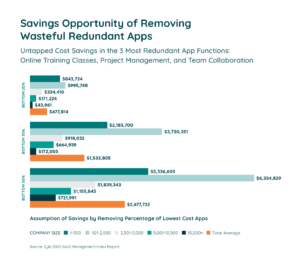
SaaS tools evolve quickly, and vendors frequently discontinue products, change pricing structures, or remove support. Without proactive monitoring, companies risk relying on applications that will soon become obsolete or incompatible with modern workflows.
Think of Google’s long list of discontinued services—applications once considered essential, only to be phased out over time. Software products can disappear unexpectedly due to acquisitions, declining usage, or vendor shutdowns, leaving organizations scrambling to find replacements.
With a structured application rationalization framework, businesses can anticipate these changes, identify tools at risk of sunsetting, and transition to more stable solutions before disruptions occur. This proactive approach helps minimize risk, ensure business continuity, and avoid costly last-minute migrations.
Holding onto outdated software for the sake of familiarity is risky. Older applications often have security vulnerabilities, lack vendor support, and limited integrations. The benefits of replacing them far outweigh the risks of keeping a system just because it’s familiar.
Application rationalization is a critical step in mitigating security risks and ensuring compliance. A thorough SaaS assessment should include an evaluation of security vulnerabilities to protect against breaches, data leaks, and regulatory penalties.
Using outdated or non-compliant tools can create major challenges when meeting data privacy regulations. If your organization struggled with the transition to GDPR in 2018 or is working to align with evolving frameworks like CCPA, you know firsthand how compliance gaps can lead to costly fines and legal exposure.
A cluttered SaaS environment drives up costs and slows employees down. When different departments adopt overlapping software without coordination, efficiency suffers. Employees waste time navigating redundant tools, leading to unnecessary complexity and inconsistent workflows.
Application rationalization eliminates this inefficiency by streamlining the software stack to just the necessary applications. Standardizing software across departments improves collaboration, reduces the learning curve, and allows employees to focus on high-impact work instead of juggling unnecessary systems.
Shadow IT—unapproved employee software purchases—creates security risks, compliance issues, and redundant spending. According to the 2025 SaaS Management Index Report, it accounts for 3.8% of an organization’s SaaS spend and 33.6% of total applications. These unauthorized tools introduce data vulnerabilities, duplicate costs, and integration challenges, making them a hidden liability for IT teams. Organizations must identify non-compliant applications, enforce governance policies, and eliminate unauthorized software to mitigate these risks.
Without clear guidelines, different teams often select their own tools, leading to SaaS sprawl and a fragmented software environment. This lack of standardization results in compatibility issues, data silos, and inconsistent workflows that slow down operations.
Application rationalization helps establish a unified approach to software selection and usage. By identifying the most effective tools and eliminating unnecessary overlap, companies can ensure all teams work within a standardized software ecosystem.
This improves collaboration, reduces onboarding time for new employees, and simplifies IT management. A well-defined application rationalization strategy also helps enforce company-wide policies on software usage, ensuring greater alignment across departments.
Adobe Drives Innovation and Massive Savings with Zylo
In the past 4 years, Adobe has rapidly scaled from $9B to $18B. This growth has made an already complex environment even more complex. Learn how they leveraged Zylo to get complete visibility into their SaaS portfolio, unlock millions in cost savings and avoidance and improve the employee experience.
Many organizations struggle with software sprawl because they lack complete visibility into their SaaS environment. Without clear insights, businesses may continue paying for redundant tools or miss opportunities to optimize spending.
IT leaders gain data-driven insights into software usage, licensing, and overall value by implementing a structured application rationalization framework. Understanding which applications contribute to business goals and which create inefficiencies allows decision makers to make informed choices about renewals, consolidations, and future software investments. With a simplified, data-backed approach, businesses can optimize their technology stack and allocate resources more effectively.
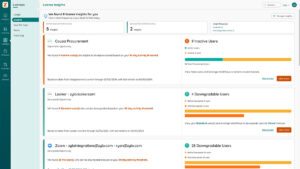
Managing a sprawling SaaS portfolio puts a significant strain on IT teams. Supporting a growing number of applications requires constant oversight, from handling security updates and compliance checks to troubleshooting integration issues. The more complex the environment, the more time and resources IT must dedicate to maintenance instead of strategic initiatives.
Application rationalization reduces this burden by consolidating software and streamlining management. A leaner, more organized SaaS environment allows IT teams to work more efficiently, reducing the time spent on redundant tasks and improving overall operational agility. Simplifying the software ecosystem also enhances system performance, making it easier to scale and adapt as business needs evolve.
Organizations don’t undertake application rationalization without a reason—specific triggers make it necessary. Whether driven by business shifts, technology upgrades, or unexpected challenges, companies must regularly evaluate their software portfolio to stay competitive and cost-efficient. Below are some of the most common drivers for application rationalization.
Many legacy applications become obsolete or redundant as businesses shift from on-premises infrastructure to cloud-based solutions. Moving to the cloud often highlights inefficiencies in the existing software stack, prompting organizations to evaluate which essential tools should be retired. Rationalization ensures that cloud migration is cost-effective and that businesses only migrate applications that provide real value.
When two companies merge, so do their SaaS portfolios. This often results in significant software duplication, as each company may use different tools for the same function. Without rationalization, organizations may end up maintaining unnecessary licenses, increasing costs and operational complexity. A structured application rationalization strategy helps streamline software assets post-merger, ensuring the newly integrated company operates with a unified and efficient technology stack.
Marigold Uses Zylo to Save on Sprawling SaaS Costs & Streamline M&A Technology Integration
Discover how Marigold unlocked the door to nearly $1M in SaaS cost savings with Zylo, while undergoing a M&A tech integration and cutting software waste from their portfolio.
Economic conditions, shifting budgets, and efficiency initiatives often push businesses to consolidate their technology investments. Over time, software portfolios can become bloated with underused or redundant applications, increasing costs without delivering proportional value. By rationalizing their application stack, businesses can eliminate waste, standardize tools across departments, and reallocate savings to high-impact technology investments.
Digital transformation is driving businesses to adopt new technologies to enhance customer interactions. Companies expanding into mobile platforms, AI-driven support, or omnichannel engagement often find that their existing applications no longer meet their needs. Application rationalization helps organizations determine which tools support their customer engagement goals and which should be phased out in favor of more advanced or integrated solutions.
Unexpected disruptions—such as cybersecurity breaches, economic downturns, or global crises—often force organizations to reassess their technology investments. Companies may need to scale back spending, improve security measures, or transition to more resilient systems. Application rationalization provides a structured approach to making these adjustments, ensuring businesses can respond effectively to challenges without sacrificing operational continuity.
While application rationalization delivers many benefits, organizations typically undertake this process with specific goals in mind. Rationalizing a software portfolio isn’t just about cutting costs—it’s about ensuring that every application serves a purpose, aligns with business objectives, and supports long-term growth. Below are some key objectives of application rationalization.
One primary objective of application rationalization is to identify and eliminate wasteful spending. Many organizations unknowingly pay for redundant software, unused licenses, and overlapping functionality. By thoroughly analyzing their SaaS environment, businesses can pinpoint where money is wasted and redirect it toward high-impact investments. Optimizing software spend allows organizations to maximize their technology budget while reducing financial inefficiencies.
With increasing data privacy and security regulations, businesses must ensure that every application in their portfolio meets compliance requirements. Application rationalization helps organizations assess which tools adhere to security and governance policies and which pose potential risks. Removing non-compliant software minimizes exposure to regulatory penalties, strengthens data protection measures, and ensures all tools align with industry standards.
Businesses frequently add new applications to address emerging needs, but without a structured rationalization process, this can lead to unnecessary complexity. A key objective of application rationalization is to provide IT and finance leaders with a clear, data-driven view of their software portfolio. Understanding which applications deliver measurable value allows decision makers to make more strategic investments, ensuring resources are allocated to tools that support business growth and efficiency.
A fragmented software ecosystem makes it challenging for organizations to stay aware of usage, spending, and security risks. Building awareness around the entire SaaS portfolio helps IT teams and executives understand which tools are in use, who owns them, and how they contribute to business operations. With greater transparency, companies can enforce better governance, reduce shadow IT, and create a more efficient technology environment.
While application rationalization offers significant benefits, organizations often face roadblocks that can delay or derail the process. Below are some of the most common challenges businesses encounter when rationalizing their software portfolios.
Without leadership support, rationalization efforts can stall. Business units may resist changes, fearing disruption, while executives hesitate due to upfront costs. To secure buy-in, IT and finance teams must present a clear business case, showing how rationalization cuts costs, improves security, and enhances efficiency. Engaging stakeholders early helps align priorities and prevent pushback.
Today, IT is responsible for just 26% of SaaS spend and 16% of applications. Meanwhile, lines of business and individual employees are responsible for the rest.

When departments independently purchase software, redundancy and inefficiencies grow. Without IT oversight, companies lose visibility into their SaaS landscape. Breaking down silos requires governance policies that encourage collaboration and transparency in software decisions, preventing future sprawl.
Application rationalization requires time and effort and often competes with other IT priorities. A phased approach—starting with high-cost or redundant apps—can help. Leveraging automation tools, like Zylo’s AI-powered Discovery Engine, also reduces manual workload and makes rationalization more scalable.
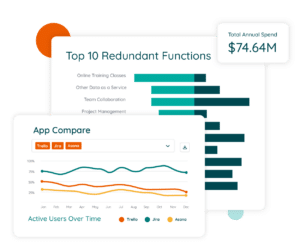 SaaS vendors frequently alter pricing, features, and product offerings, making maintaining a stable software portfolio difficult. Organizations should treat rationalization as an ongoing process, conducting regular audits and adapting their software stack to market shifts.
SaaS vendors frequently alter pricing, features, and product offerings, making maintaining a stable software portfolio difficult. Organizations should treat rationalization as an ongoing process, conducting regular audits and adapting their software stack to market shifts.
Removing deeply embedded applications can be challenging without disrupting workflows. To ensure a smooth transition, IT teams must evaluate software dependencies before decommissioning tools. Choosing replacements with strong integrations minimizes disruption.
Incomplete or fragmented data makes it challenging to assess software usage and waste. A centralized SaaS management platform provides real-time insights, allowing businesses to make data-driven decisions on renewals, consolidations, and deprecations.
Employees often resist switching applications due to attachment to their favorite apps, learning curves, or past negative experiences. A structured change management strategy—including training, clear communication, and user involvement—improves adoption and minimizes disruptions.
If past rationalization efforts failed due to lack of support, poor data, or incomplete execution, employees may be skeptical. Learning from past mistakes, securing leadership buy-in, and setting realistic goals ensure a more successful outcome.
Unexpected issues, like hidden software dependencies or contract complexities, can derail rationalization efforts. Thorough impact analysis, pilot testing, and a flexible approach help mitigate risks and ensure a smooth process.
Application rationalization initiatives often face pushback from leadership, IT teams, and department heads. Resistance comes from concerns about disruption, cost, and the effort required to evaluate and consolidate software. Gaining stakeholder support is essential for a smooth, successful rationalization process. Below are key strategies to secure buy-in and address common challenges.
Stakeholders are more likely to support rationalization when they see how it aligns with company objectives. Position rationalization as a way to optimize budgets, improve security, and streamline operations. When presenting the initiative, focus on measurable business outcomes, such as cost savings, compliance improvements, and increased efficiency.
One of the most effective ways to gain leadership buy-in is to present the potential cost savings from software consolidation. Use real data to illustrate how much the company spends on redundant applications and overlapping tools. Highlight clear opportunities to streamline the SaaS portfolio by eliminating duplicate solutions and centralizing functionality within fewer platforms. By demonstrating what’s possible, organizations can make informed decisions about where to cut costs and how to reallocate savings toward higher-value investments.
Stakeholders may worry that rationalization will disrupt workflows or limit department autonomy. To overcome this, emphasize how rationalization makes employees’ jobs easier. If you’re talking to a line of business leader, illustrate how eliminating some applications will free up money for other investments. Standardizing software can reduce the learning curve, simplify collaboration, and ensure teams can access the best-fit tools without unnecessary complexity.
Resistance often comes from fear of operational disruptions or losing critical functionality. To mitigate these concerns, emphasize that rationalization doesn’t mean cutting essential tools—it means making smarter software decisions. Offer a phased approach, starting with low-risk changes and gradually addressing more complex software consolidations.
Stakeholders may hesitate to approve rationalization efforts without understanding software usage and value. SaaS Management tools can provide real-time data on application usage, costs, and redundancies. A data-driven approach builds confidence in the rationalization strategy and helps decision makers see the full picture.
Stakeholders are more likely to support rationalization if they see it as an ongoing process rather than a one-time effort. Establish clear governance policies to ensure that software decisions align with company goals moving forward. Define approval processes for new software purchases, set renewal guidelines, and assign ownership to maintain visibility and control.
Getting leadership and department heads involved from the beginning prevents resistance later. Encourage cross-functional collaboration by including representatives from IT, finance, security, and business units in the rationalization process. When stakeholders feel heard and included, they are more likely to support and champion the initiative.
For instance, start by gathering data on user sentiment to understand whether employees like the tools they’re using. In addition, connect one on one with users to gain context on how an app is used. This becomes valuable data when evaluating which tools to keep or deprecate.
Stakeholders are more likely to stay engaged when they see tangible results. Track and share early wins, such as reduced costs, improved security, or streamlined processes. Regular updates on progress and impact help maintain momentum and reinforce the value of rationalization efforts.
A structured application rationalization framework ensures organizations take a strategic, repeatable approach to optimizing their software portfolio. As part of a broader Enterprise SaaS Management Framework, application rationalization helps businesses systematically evaluate and refine their software ecosystem. While the exact methodology varies by company, a successful framework typically follows these key phases:
By following a proven application rationalization methodology, companies can reduce redundancy, optimize costs, and create a more secure, efficient SaaS environment.
The Definitive Guide to SaaS Management
Learn MoreApplication rationalization is not a one-size-fits-all process, but following a structured approach ensures efficiency and long-term success. Below is a refined framework with steps to help you streamline your software portfolio while aligning with business objectives.
A clear strategy begins with identifying key objectives and success metrics. Before analyzing applications, determine what outcomes your organization wants to achieve. Examples include cost savings, security improvements, or standardization.
Understanding the full scope of the software portfolio is the foundation of rationalization. This step involves collecting detailed data on all applications, including:
Rather than relying on manual spreadsheets, using a SaaS Management platform like Zylo gives you a real-time, comprehensive inventory with licensing details, active user data, and contract visibility.
Each application should be evaluated based on how well it serves business objectives. This step helps determine whether a tool is necessary, redundant, or misaligned with company needs. Consider factors such as:
Once you’ve assessed the applications, ranking them based on business value, cost, and usability helps prioritize next steps. A practical evaluation includes:
After analyzing the software portfolio, sort the applications into action categories to guide the rationalization process.
Applications that see widespread use, provide high business value, and meet security and compliance standards should remain in place with continued monitoring.
Software that is outdated, underutilized, or no longer aligns with business objectives should be phased out. When retiring applications, consider contract terms, migration plans, and user impact.
Some tools may need to be moved to a different hosting environment, such as transitioning from on-premises to the cloud for better performance and scalability.
Applications that lack essential features or have become inefficient should give way to more modern, cost-effective alternatives. Standardizing software across teams reduces redundancy and improves collaboration.
A phased implementation plan ensures that software changes happen smoothly with minimal disruption. Key considerations include:
With a roadmap in place, execution involves systematically implementing rationalization decisions while minimizing business disruption. This step requires collaboration between IT, finance, security, and business units to ensure a seamless transition.
Key actions during execution:
Using a SaaS Management Platform streamlines execution by providing real-time insights into software usage, license management, and spending, ensuring the process remains data-driven.
Application rationalization isn’t a one-time initiative—it should be an ongoing process that continuously aligns the software portfolio with business objectives. Without regular review, SaaS sprawl can return, leading to wasted resources and inefficiencies. Regular audits and governance policies prevent software sprawl and ensure the SaaS portfolio remains optimized over time.
Best practices for maintaining an optimized SaaS portfolio:
Embedding application rationalization into ongoing IT and finance operations ensures long-term cost efficiency, security, and business alignment.
By following this approach, organizations can proactively manage their SaaS environment, eliminate waste, and ensure every application serves a strategic purpose.
Maximizing the value of your SaaS investments requires more than a one-time rationalization effort. These best practices help ensure ongoing success.
Treat application rationalization as an ongoing function, not just a one-time cleanup. Regular audits and governance policies prevent software sprawl and ensure new applications align with business goals.
Cross-functional collaboration between IT, finance, security, and business units improves visibility and accountability. Encouraging departments to communicate software needs helps prevent shadow IT and redundant purchases.
Creating standardized operating procedures (SOPs) for software adoption, usage, and retirement helps maintain efficiency. Employees should receive training on approved tools to improve adoption rates and reduce reliance on redundant applications.
Getting buy-in from leadership and end users ensures smoother implementation. Engaging stakeholders early in the rationalization process minimizes resistance and promotes alignment with business needs.
Regularly track application usage, spending, and ROI. Leveraging a SaaS Management Platform provides real-time insights into software performance, helping organizations adjust their portfolios as needs evolve.
Effective application rationalization can lead to substantial cost savings, streamlined operations, and enhanced innovation. Below are two notable examples:
Adobe, a global leader in digital media and marketing solutions, experienced rapid growth, scaling from $9 billion to $18 billion in just four years. This expansion led to a sprawling software environment, with thousands of third-party applications in use, making software Adobe’s third-largest expense. The lack of visibility into their software portfolio resulted in unmanaged subscriptions, increased risk, and a fragmented employee experience.
To address these challenges, Adobe partnered with Zylo to gain comprehensive insight into their SaaS usage and spending. Leveraging Zylo’s platform, Adobe identified and categorized over 2,600 applications, uncovering redundancies and opportunities for consolidation. This rationalization effort led to the reduction of software titles from 2,500 to 400 standard tools, unlocking $60 million in cost savings and avoidance.
Additionally, Adobe established the Workspace Store, a centralized software catalog, enhancing governance and significantly improving the employee experience by providing a single avenue for software requests.
Marigold, a global marketing technology company, faced the complexities of integrating multiple acquisitions, which introduced overlapping applications and increased SaaS expenditures. Without a unified system to track and manage these applications, inefficiencies and unnecessary costs became prevalent.
By implementing Zylo’s SaaS management platform, Marigold established an organized system of record, providing clear visibility into their SaaS environment. This enabled them to identify and cancel 166 redundant applications, leading to significant cost savings. During mergers and acquisitions, Marigold utilized Zylo to integrate acquired companies’ SaaS portfolios efficiently, eliminating functional overlaps and streamlining operations. Over two years, these efforts resulted in negotiated savings exceeding $775,000, demonstrating the value of proactive application rationalization in complex business scenarios.
Organizations that implement a structured rationalization strategy see measurable efficiency, cost savings, and security improvements. While case studies vary, common success metrics include:
For more real-world examples, explore Zylo’s case studies on how companies successfully optimized their SaaS portfolios.
Effectively managing a SaaS portfolio requires the right tools to analyze, optimize, and streamline software usage. Application rationalization tools help organizations identify redundant applications, track usage patterns, and make data-driven decisions about consolidating or eliminating software. By leveraging these solutions, businesses can improve efficiency, reduce costs, and maintain a well-governed technology environment.
Gaining full visibility into your organization’s SaaS portfolio is the first step in rationalization. Zylo’s AI-powered Discovery Engine provides complete visibility into shadow IT, enabling proactive monitoring and enforcement. By implementing structured oversight, businesses can improve security, control costs, and maintain a more efficient SaaS portfolio.

Understanding software usage is critical for reducing waste. Zylo tracks real-time user activity, helping businesses pinpoint underutilized applications and adjust licenses accordingly. This prevents unnecessary spending on unused or duplicate software.
Zylo’s User Overlap makes it easy for organizations to identify which employees have access to redundant applications. Then, examining usage gives you the right data to determine which apps to keep and which to deprecate.
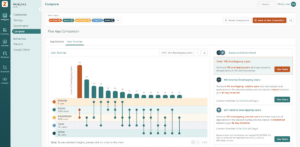
Without a structured approach to SaaS renewals, businesses often overpay for software or miss opportunities to consolidate contracts. Zylo centralizes contract details, automates renewal tracking, and provides data-driven insights for better negotiation.
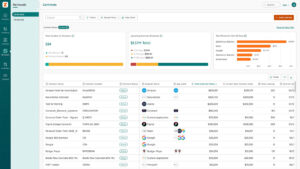
SaaS spending can quickly spiral out of control without proactive management. Zylo helps organizations analyze software costs, identify cost-saving opportunities, and ensure that technology investments align with business goals.
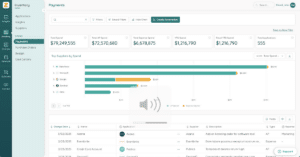
Non-compliant applications pose security risks and potential legal issues. Zylo’s Security Detail, powered by Netskope, helps organizations assess the compliance status of their SaaS applications, making it easier to identify and mitigate risks. Regularly updating applications and shifting to more secure, well-supported software reduces security liabilities and protects critical business data.
With Zylo, IT teams can quickly identify which applications store sensitive customer information, such as PII or financial data, and take action to secure that data. Strengthening security posture through application rationalization minimizes the risk of breaches and helps organizations stay ahead of shifting compliance requirements.
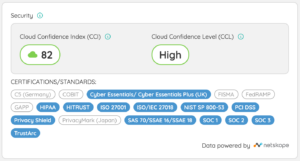
AI is transforming how organizations approach application rationalization by enhancing analytics, automating processes, and enabling smarter decision-making. Here’s how AI-driven solutions are shaping the future of SaaS management.
AI-driven platforms can forecast software usage trends, helping organizations proactively adjust their SaaS portfolios before inefficiencies arise. Predictive insights ensure businesses make data-backed decisions to optimize their software investments.
Automation reduces the manual effort required for application rationalization. AI tools can categorize applications, flag redundancies, and recommend optimizations, allowing IT teams to focus on strategic initiatives.
AI-powered decision support systems analyze business needs, software performance, and cost data to recommend the best application portfolio structure. These tools help IT leaders justify rationalization decisions with concrete data.
As organizations migrate to the cloud, AI helps identify the best-fit applications for cloud environments, assess licensing needs, and prevent unnecessary software sprawl.
Application rationalization evaluates an organization’s software portfolio to determine which applications should be retained, replaced, consolidated, or retired based on business value, cost, and usage.
Application rationalization helps reduce software costs, improve operational efficiency, enhance security, standardize tools, and align IT investments with business objectives.
Common challenges include lack of visibility, resistance to change, and resource constraints. These can be addressed by leveraging SaaS Management tools, securing leadership buy-in, and implementing a phased rationalization approach.
Cloud migration rationalization involves evaluating which applications should be moved to the cloud, rehosted, or replaced with cloud-native solutions to optimize performance and cost.
Rationalization aligns IT strategy with business goals by eliminating redundant applications, improving system integration, and ensuring technology investments support long-term growth.
Organizations can cut unnecessary software spending, reduce license waste, and streamline IT operations by identifying unused or redundant applications.
Ignoring rationalization can lead to excessive SaaS spending, security vulnerabilities, compliance issues, and inefficiencies that hinder business performance.
Successful application rationalization requires visibility, automation, and strategic insights. Zylo empowers organizations to take control of their SaaS environment, optimize software investments, and drive cost savings.
Want to see what software standardization at scale looks like? Adobe reduced 2,500 software titles to 400 standard tools, saving millions in the process.

Table of Contents ToggleWhat Are Longtail SaaS Applications?The Rise of Longtail...

Table of Contents ToggleEpisode SummaryGuest SpotlightEpisode HighlightsSourcing Teams Are Key to...

Table of Contents ToggleApplication Rationalization BenefitsWhat Drives the Need for Application...
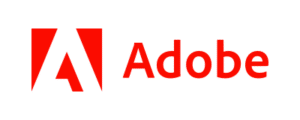
In the past 4 years, Adobe has rapidly scaled from $9B to $18B. This growth has made an already complex environment even more complex. Learn how they leveraged Zylo to get complete visibility into their SaaS portfolio, unlock millions in cost savings and avoidance and improve the employee experience.
| Cookie | Duration | Description |
|---|---|---|
| cookielawinfo-checkbox-analytics | 11 months | This cookie is set by GDPR Cookie Consent plugin. The cookie is used to store the user consent for the cookies in the category "Analytics". |
| cookielawinfo-checkbox-functional | 11 months | The cookie is set by GDPR cookie consent to record the user consent for the cookies in the category "Functional". |
| cookielawinfo-checkbox-necessary | 11 months | This cookie is set by GDPR Cookie Consent plugin. The cookies is used to store the user consent for the cookies in the category "Necessary". |
| cookielawinfo-checkbox-others | 11 months | This cookie is set by GDPR Cookie Consent plugin. The cookie is used to store the user consent for the cookies in the category "Other. |
| cookielawinfo-checkbox-performance | 11 months | This cookie is set by GDPR Cookie Consent plugin. The cookie is used to store the user consent for the cookies in the category "Performance". |
| viewed_cookie_policy | 11 months | The cookie is set by the GDPR Cookie Consent plugin and is used to store whether or not user has consented to the use of cookies. It does not store any personal data. |
